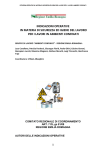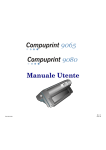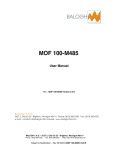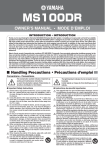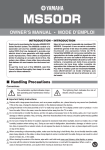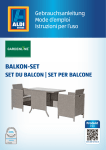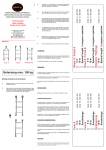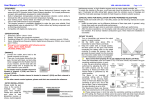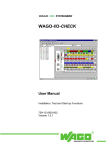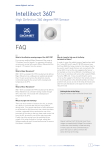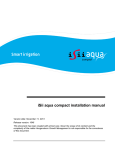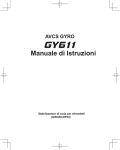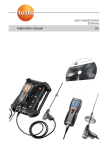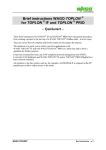Download 09.10.2002, 700 kByte, 16 Seiten
Transcript
750-804 Interbus PFC Configuring & Networking Application note A202501, English Version 1.0.0 2 • General Copyright ã 2002 by WAGO Kontakttechnik GmbH All rights reserved. WAGO Kontakttechnik GmbH Hansastraße 27 D-32423 Minden Phone: +49 (0) 571/8 87 – 0 Fax: +49 (0) 571/8 87 – 1 69 E-Mail: [email protected] Web: http://www.wago.com Technical Support Phone: +49 (0) 571/8 87 – 5 55 Fax: +49 (0) 571/8 87 – 85 55 E-Mail: [email protected] Every conceivable measure has been taken to ensure the correctness and completeness of this documentation. However, as errors can never be fully excluded we would appreciate any information or ideas at any time. We wish to point out that the software and hardware terms as well as the trademarks of companies used and/or mentioned in the present manual are generally trademark or patent protected. Application note A202501 Table of Contents •3 TABLE OF CONTENTS 1 Important comments.................................................................................. 4 1.1 Legal principles............................................................................................ 4 1.1.1 Copyright .......................................................................................... 4 1.1.2 Personnel qualification ..................................................................... 4 1.1.3 Intended use ...................................................................................... 4 1.2 Range of validity.......................................................................................... 5 2 Description.................................................................................................. 6 3 Reference Material..................................................................................... 7 3.1 PFC I/O Module Addressing........................................................................ 7 3.1.1 PFC to Network variable addressing ................................................ 7 3.2 Configuration of the master scanner card .................................................... 8 3.3 WAGO IO Pro 32 test network communication program ......................... 11 3.4 Manipulation and Monitoring with NETCON........................................... 13 Application note A202501 4• Important comments 1 Important comments To ensure fast installation and start-up of the units described in this manual, we strongly recommend that the following information and explanation is carefully read and adhered to. 1.1 Legal principles 1.1.1 Copyright This manual is copyrighted, together with all figures and illustrations contained therein. Any use of this manual which infringes the copyright provisions stipulated herein, is not permitted. Reproduction, translation and electronic and photo-technical archiving and amendments require the written consent of WAGO Kontakttechnik GmbH. Non-observance will entail the right of claims for damages. 1.1.2 Personnel qualification The use of the product detailed in this manual is exclusively geared to specialists having qualifications in PLC programming, electrical specialists or persons instructed by electrical specialists who are also familiar with the valid standards. WAGO Kontakttechnik GmbH declines all liability resulting from improper action and damage to WAGO products and third party products due to non-observance of the information contained in this manual. 1.1.3 Intended use For each individual application, the components supplied are to work with a dedicated hardware and software configuration. Modifications are only admitted within the framework of the possibilities documented in the manuals. All other changes to the hardware and/or software and the non-conforming use of the components entail the exclusion of liability on part of WAGO Kontakttechnik GmbH. Please direct any requirements pertaining to a modified and/or new hardware or software configuration directly to WAGO Kontakttechnik GmbH. Application note A202501 Important comments •5 1.2 Range of validity This application note is based on the stated hardware and software of the specific manufacturer as well as the correspondent documentation. This application note is therefore only valid for the described installation. New hardware and software versions may need to be handled differently. Please note the detailed description in the specific manuals. Application note A202501 6• Description 2 Description This document is to be used with the example node from the document PFC 101 Get Started Quick. The following describes Configuring and networking the example node using the software and equipment listed below. 750-804 Interbus PFC WAGO/Hilscher Interbus Master scanner card, WAGO Netcon WAGO IO Pro 32 software. The modules used in this example: 750-804 1 Interbus PFC 750-402 1 Digital Input module, 4 point, 24Vdc 750-504 1 Digital Output module, 4 point, 24Vdc 750-550 1 Analog Output module, 2 Chan, 0-10Vdc 750-467 1 Analog Input module, 2 Chan, 0-10Vdc 750-600 1 End module The Interbus protocol requires a Master Scanner Card at the PC/PLC to communicate with the slave devices on the network. The master scanner card requires a reference or “picture” of all the data to be sent and received on the network, and the order that it resides. This picture is called the process image, and is stored in the master scanner card memory. Deviation from this application note may be required when using other hardware and or software. For other details about WAGO Interbus 750- 804 please refer to the WAGO Users Manual 750-132. The Files and Programs in this document can be downloaded from the web site www.wago.com Application note A202501 Reference Material 3 •7 Reference Material 3.1 PFC I/O Module Addressing In a PFC program, direct addressing of the IO modules will be in the following format: 1. Analog and specialty module data is addressed first 2. Digital module data addressed next 3. Addressing is sequential and starts at word 0 Addressing of the 750-804 example node will be as follows: Inputs Address Variable Outputs Address Variable 750-467 %IW0 AIChan1 750-550 %QW0 AOChan1 %IW1 AIChan2 %QW1 AOChan2 %IX2.0 Input0 %QX2.0 Output0 %IX2.1 Input1 %QX2.1 Output1 %IX2.2 Input2 %QX2.2 Output2 %IX2.3 Input3 %QX2.3 Output3 750-402 750-504 *750-600 End Module (No memory allocation) 3.1.1 PFC to Network variable addressing The first memory location available for reading data from the network master to the PFC is %IW256. The first memory locatioin available for writing data from the PFC to the network master is %QW256. Application note A202501 8• Reference Material 3.2 Configuration of the master scanner card To configure the master scanner we must create and load a process image into the master scanner that will allow for network variable data to be sent and received. We will use the WAGO IO Pro32 and WAGO NETCON software to do this. Start the WAGO IO Pro32 software and begin a new Ladder project (LD). Open the library manager and insert the library “InterBusS.lib” (fig. 1.1 & 1.2) Fig. 1.1 Fig. 1.2 Return to the program screen and insert the function block “IBS_SET_PI_CONFIGURATION”. Enter the data into the function block variables as shown in (fig 1.3). Fig. 3.1 Application note A202501 Reference Material •9 Once you’ve completed the program, check it for errors and download it into the Interbus PFC. Since it is not possible to download the program through the Interbus connection, the serial programming cable must be used, and the communication parameters set accordingly. After the program has finished loading, using the “run” icon, start the program running, then minimize the WAGO IO Pro32 program window (do not close the program). A detailed description of the IBS_SET_PI_CONFIGURATION function block can be found in the WAGO IO Pro32 User manual (759-122/000-002). In this example, we have created a program that will create a process image for the master scanner card, containing the data of the 4 IO modules connected to the PFC and also 1 word each of output data to the master and input data to the PFC. Now the process image has to be loaded into the master scanner card. Start the WAGO NETCON software and begin a new project for Interbus. Insert an Interbus master device into the project using the insert master icon (Fig 1.4). A window will open listing available devices. Select the appropriate device that corresponds to your scanner card and add it to Selected devices. You will be notified by the program when your master scanner card is detected (Fig 1.5). A visual representation of a master will now be visible on the screen. Right mouse click on the master and select Master Settings. Under storage format, select Little Endian, and then o.k. This enables the Motorola data format. Fig 1.4 Application note A202501 Fig 1.5 10 • Reference Material Using the “insert remote bus device” icon, insert a remote device in the light blue circle that appears under the master. In the window that opens, select “750-304/334 WAGO I/O System Interface” from the list of available Fig. 1.6 Fig. 1.7 devices. You will see 3 devices with this same name in the list. You will need to look at the “Short type” under the device list and select the one that is Analog Input / Output (Fig 1.6). Select the Add button to move the device over to the Selected devices list. Name this device WAGO PFC in the description and select OK. Goto the Online dropdown menu and select Automatic Network Scan… this will initiate a network scan for connected devices. A window should open containing the results of the scan (device, length code, ID code, and level). Select the Automatic configuration button (Fig 1.7). Again going to the Online dropdown menu, select Download…this will load the process image into the master scanner card. Minimize WAGO NETCON. Application note A202501 Reference Material • 11 3.3 WAGO IO Pro 32 test network communication program Go back to the WAGO IO Pro screen. Stop the current program and log out of the buscoupler. Close that project and start a new Ladder project. Enter the following program and load it into the PFC (Fig 1.8). When the program has finished downloading, run it. Fig. 1.8 It is important to note that when creating a PFC program for use in an Interbus PFC, you must decide ahead of time how you want your real world IO points accessed. Any IO modules that are listed in the IBS_SET_PI_CONFIGURATION block, in the case of outputs, can only be directly accessed by the Interbus Master. In the case of Inputs, both the Interbus master and PFC can directly access the data. If no modules are listed in the function block, only the PFC will have direct access to real world input and output data. Network variables would have to be used by the Interbus master to access input data or write output data. Application note A202501 12 • Reference Material Rung 1: INPUT0 is the first Input from the first digital input module. OUTPUT0 is the first Output from the first digital output module. When INPUT0 is On, OUTPUT0 turns On. The PFC has control of the output. When monitoring the PFC, the output will turn on when the input turns On. If the output does not turn on, check the PFC Program for correct addressing of the input and output modules. If the output is used in the PFC program, do not try to write to this output directly from the Master. Write the data to the Network variable holding area of memory and then use that memory location in the PFC program. Always let the PFC do the logic solving. Rung 2: INPUT256 (%IW256) is the first PFC memory location that the first word of Network Output Variable information is placed by the Interbus master. Using the ADD operator to add 0 to INPUT256, this transfers the data from INPUT256 to AOCHAN1 (%QW0) which is addressed to channel 1 of the analog output module. This is an example of how to enable real world IO manipulation by the master, using the PFC program. You will see when writing a value in the first output word of NETCON, the same value will appear at INPUT256 and in turn, be forwarded on to AOCHAN1. Rung 3: This rung is used to clock the up counter in rung 4. Rung 4: Every time the timer RESET is true, it adds one count to the up counter. OUTPUT256 (%QW256) is the first memory location of the PFC to place data that is to be sent back to the Interbus master. Compare the data of OUTPUT256 and the first input word in NETCON. The data should count up with the PFC. The PFC program and NETCON configuration is a small example to demonstrate how to read/write data to the Interbus PFC. If one of these steps is not working correctly, check the register addressing in the PFC. Application note A202501 Reference Material • 13 3.4 Manipulation and Monitoring with NETCON Restore the WAGO NETCON screen and switch to the Logical Network View in the Window drop down menu. Here you will find a single unnamed object in the menu tree. Expand the object in the tree to show the Master scanner. Expand further to show Diagnostics and Device1. Expand the Device1 to show Module1 and Module2. These 2 items will have tags associated with them in the Tag List. Module1 contains one word (16 bit unsigned integer) of input data. Fig 1.9 Module2 contains one word (16 bit unsigned integer) of output data. This is the PLC_IN and PLC_OUT data that was placed into the process image. Select the input tag for Module1 and then go to the Online drop down menu to select Monitor(Fig 1.9). You should now see a number in the value column that is incrementing at the same pace and be almost identical in value as the variable Output256 (%QW256) in the test program (the values will not be identical due to time lag for data transfer). Now select Module2 and the output tag associated with it. Right click the mouse on the tag and select Write Value. Input a value of 2000 in the window that opens and select the write button. Look at the variable Input256 (%IW256) in the test program and you should see it now contains a value of 2000(Fig 2.0). You should also see the variable Aochan1(%QW0) contain the same value. Application note A202501 14 • Reference Material This example has shown just one of the many possible configuration possibilities of the Interbus PFC using WAGO IO Pro and WAGO NETCON. The process will not change dramatically for any configuration. It all comes down to what type of control you want from your Interbus Master vs. the local process in the PFC. Application note A202501 Reference Material Application note A202501 • 15 WAGO Kontakttechnik GmbH Postfach 2880 • D-32385 Minden Hansastraße 27 • D-32423 Minden Phone: 05 71/8 87 – 0 Telefax: 05 71/8 87 – 1 69 E-Mail: [email protected] WAGO Corporation USA N120W19129 Freistadt Road PO Box 1015 Germantown, Wi 53022 Phone: 1-262-255-6333 Fax: 1-262-255-3232 Internet: http://www.wago.com Call Toll Free: 1-800-DIN-RAIL (346-7245)
















